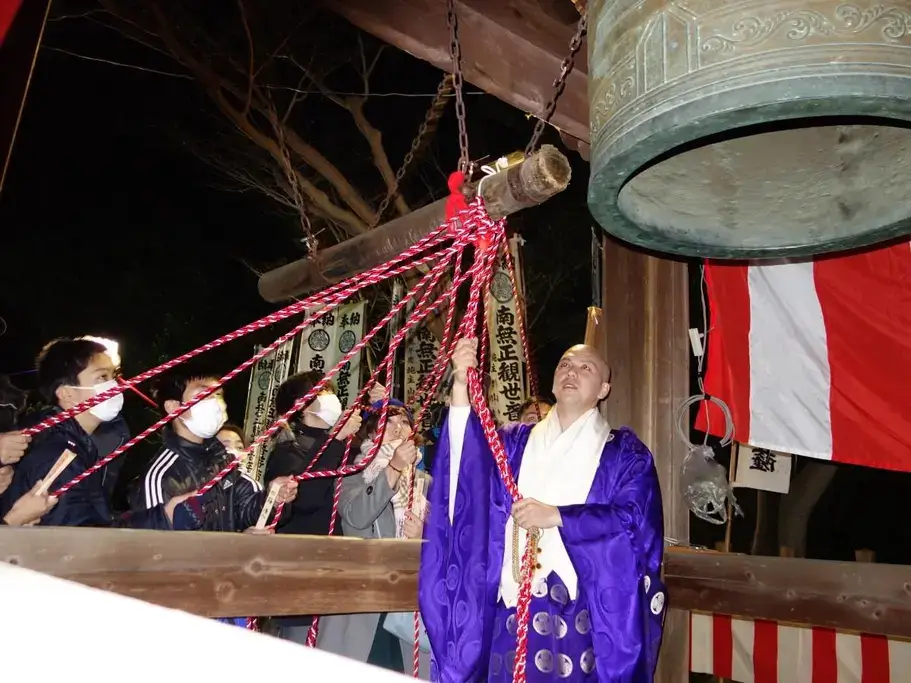Oshogatsu is Japanese New Year’s, an important holiday across the nation! From interesting snacks to midnight traditions, here’s everything you need to know about this important holiday! Let’s get started!
Table of Contents
ToggleWhat are some common traditions during New Year’s in Japan?
One of Japan’s most significant traditions during New Year’s is joya no kane, which occurs on New Year’s Eve. This custom involves ringing a temple bell 108 times at midnight. Each ring represents the cleansing of 108 worldly passions. This helps people let go of the troubles from the past year and start fresh in the new year. The final ring signifies the arrival of January 1, a day believed to bring peace and good fortune for the year ahead.

Another popular tradition is omikuji, a form of fortune-telling that many people participate in during the New Year. Visitors can draw a paper slip at Shinto shrines revealing their year’s fortune. These fortunes cover various aspects of life, such as health, love, and work. If someone receives a bad fortune, they can tie it to a tree at the shrine. This act is done in hopes of avoiding its unlucky predictions. Omikuji adds excitement and spirituality to New Year celebrations as people seek guidance and optimism for the year ahead.
What can I eat during Oshogatsu?
During Oshogatsu, one delightful treat you can enjoy is mamegashi, a wagashi made from beans and nuts. These snacks are often sweetened and flavored, creating a crunchy and satisfying treat. Mamegashi tastes great and adds a festive touch to the New Year celebrations, making it a popular choice during this special time.

Another delicious item you can find during Oshogatsu is kohakutou, a colorful, jelly-like confection made from sugar and starch. Kohakutou comes in beautiful shapes and designs and comes in various flavors, making it visually appealing and tasty.
Who are the Seven Lucky Gods?
The Seven Lucky Gods, or Shichifukujin, are a group of deities in Japanese culture believed to bring good fortune and blessings. Their origins date back to the Muromachi Era and became especially popular during Edo. This eclectic group reflects a blend of Hinduism, Buddhism, Taoism, and Shinto influences. Each god embodies different virtues, and people originally worshipped them separately before recognizing them collectively.

Among the Seven Lucky Gods, Ebisu is the only one with Japanese origins, representing fishing, commerce, and honesty. He is often depicted with a fishing rod and a sea bream. Hotei, known as the “Laughing Buddha,” symbolizes happiness and abundance, characterized by his cheerful demeanor and large belly. Lastly, artists portray Benzaiten, the goddess of arts and knowledge, as a beautiful woman playing a musical instrument. Together, these deities significantly influence Japanese culture, and people celebrate them for their diverse blessings.
Are you looking for fantastic snacks for the New Year? Check out Sakuraco! Sakuraco delivers traditional Japanese snacks, teas, and sweets from local Japanese makers directly to your door so you can enjoy the latest treats directly from Japan!
What was notable about the Year of the Snake in Japanese history?
The Year of the Snake is associated with significant events in Japanese history, symbolizing change, intelligence, and renewal. In 1989, a pivotal Year of the Snake, Japan entered the Heisei era as Emperor Akihito ascended to the throne following the death of Emperor Hirohito. This began a new chapter in Japanese history, characterized by challenges and opportunities for cultural and economic growth.

Another notable Year of the Snake was 2001, which saw the grand opening of Tokyo DisneySea on September 4th. This expansion of Tokyo Disney Resort introduced the world’s first Disney theme park centered around maritime adventures and exploration, featuring seven themed lands that quickly became beloved attractions. 2013, also a Year of the Snake, was significant as Mount Fuji, Japan’s iconic symbol, was designated as a UNESCO World Heritage Site, further cementing its cultural importance on the global stage.
Why is Oshogatsu important in Japan?
Oshogatsu represents the most significant holiday in Japanese culture, a time of profound spiritual renewal and family connection. This celebration marks a complete transition from the old year to the new, with Japanese people believing that years are entirely separate and each new year provides a fresh start. Families gather to prepare for the arrival of Toshigami-sama, the ancestral deity who brings good fortune, by thoroughly cleaning their homes and creating a welcoming environment.

The celebration has meaningful traditions connecting people to their cultural roots. On New Year’s Eve, the joya no kane ritual involves ringing temple bells 108 times at midnight, symbolically cleansing people of their past year’s troubles. People participate in hatsumode by visiting shrines and eating unique food like osechi and mamegashi, and children receive otoshidama monetary gifts.
Finally, the year’s first sunrise is considered especially auspicious, representing the year’s potential. These practices reflect a collective hope for health, prosperity, and spiritual renewal, making Oshogatsu a profoundly significant cultural moment beyond a simple calendar change. What do you find interesting about Oshogatsu? Let us know in the comments below!











